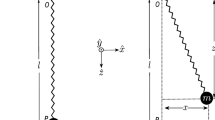Abstract
We study the dynamics of a nonlinear pendulum under a periodic force with small amplitude and slowly decreasing frequency. It is well known that when the frequency of the external force passes through the value of the frequency of the unperturbed pendulum’s oscillations, the pendulum can be captured into resonance. The captured pendulum oscillates in such a way that the resonance is preserved, and the amplitude of the oscillations accordingly grows. We consider this problem in the frames of a standard Hamiltonian approach to resonant phenomena in slow-fast Hamiltonian systems developed earlier, and evaluate the probability of capture into resonance. If the system passes through resonance at small enough initial amplitudes of the pendulum, the capture occurs with necessity (so-called autoresonance). In general, the probability of capture varies between one and zero, depending on the initial amplitude. We demonstrate that a pendulum captured at small values of its amplitude escapes from resonance in the domain of oscillations close to the separatrix of the pendulum, and evaluate the amplitude of the oscillations at the escape.
Similar content being viewed by others
References
Friedland, L., Autoresonance in Nonlinear Systems, Scholarpedia, 2009, vol. 4, no. 1, p. 5473.
Veksler, V. I., A New Method of Acceleration of Relativistic Particles, Dokl. Akad. Nauk SSSR, 1944, vol. 43, no. 8, pp. 346–348 [J. Phys. USSR, 1945, vol. 9, no. 3, pp. 153–158].
McMillan, E. M., The Synchrotron: A Proposed High Energy Particle Accelerator, Phys. Rev., 1945, vol. 68, pp. 143–144.
Arnol’d, V. I., Kozlov, V.V., and Neishtadt, A. I., Mathematical Aspects of Classical and Celestial Mechanics, 3rd ed., Encyclopaedia Math. Sci., vol. 3, Berlin: Springer, 2006.
Sinclair, A.T., On the Origin of Commensurabilities amongst Satellites of Saturn, Monthly Not. Roy. Astron. Soc., 1972, vol. 160, no. 2, pp. 169–187.
Greenberg, R. J., Evolution of Satellite Resonances by Tidal Dissipation, Astron. J., 1973, vol. 78, no. 4, pp. 338–346.
Henrard, J. and Lemaitre, A., A Second Fundamental Model for Resonance, Celestial Mech., 1983, vol. 30, pp. 197–218.
Neishtadt, A. I. and Timofeev, A.V., Autoresonance in Electron Cyclotron Heating of a Plasma, ZhETF, 1987, vol. 93, no. 5(11), pp. 1706–1713 [JETP, 1987, vol. 66, no. 5, pp. 973–977].
Kotel’nikov, I.A. and Stupakov, G.V., Adiabatic Theory of Nonlinear Electron-Cyclotron Resonance Heating, J. Plasma Phys., 1991, vol. 45, no. 1, pp. 19–27.
Neishtadt, A. I. and Vasiliev, A. A., Capture into Resonance in Dynamics of a Classical Hydrogen Atom in an Oscillating Electric Field, Phys. Rev. E, 2005, vol. 71, no. 5, 056623, 6 pp.
Neishtadt, A. I., Passage through a Separatrix in a Resonance Problem with a Slowly-Varying Parameter, Prikl. Mat. Mekh., 1975, vol. 39, no. 4, pp. 621–632 [J. Appl. Math. Mech., 1975, vol. 39, no. 4, pp. 594–605].
Fajans, J. and Friedland, L., Autoresonant (Nonstationary) Excitation of Pendulums, Plutinos, Plasmas, and Other Nonlinear Oscillators, Amer. J. Phys., 2001, vol. 69, pp. 1096–1102.
Sagdeev, R. Z., Usikov, D.A., and Zaslavsky, G.M., Nonlinear Physics: From the Pendulum to Turbulence and Chaos, New York: Harwood Acad. Publ., 1988.
Handbook of Mathematical Functions with Formulas, Graphs, and Mathematical Tables, M. Abramowitz and I.A. Stegun (Eds.), Appl. Math. Ser., vol. 55, Washington, DC: National Bureau of Standards, U.S. Government Printing Office, 1964.
Neishtadt, A. I., On Adiabatic Invariance in Two-Frequency Systems, in Hamiltonian Systems with Three or More Degrees of Freedom, NATO ASI Series, Series C, vol. 533, Dordrecht: Kluwer Acad. Publ., 1999.
Neishtadt, A. I. and Vasiliev, A. A., Destruction of Adiabatic Invariance at Resonances in Slow-Fast Hamiltonian Systems, Nuclear Instruments & Methods in Physics Research Section A, 2006, vol. 561, no. 2, pp. 158–165.
Friedland, L., Migration Timescale Thresholds for Resonant Capture in the Plutino Problem, Astroph. J. Lett., 2001, vol. 547, L75–L79.
Makarov, D.V., Uleysky, M.Yu., and Prants, S.V., Control of Atomic Transport Using Autoresonance, in Chaos, Complexity and Transport, X. Leoncini, M. Leonetti (Eds.), Singapore: World Sci., 2012, pp. 24–32.
Itin, A.P., Neishtadt, A. I., and Vasiliev, A. A., Captures into resonance and scattering on resonance in dynamics of a charged relativistic particle in magnetic field and electrostatic wave, Physica D, 2000, vol. 141, pp. 281–296.
Author information
Authors and Affiliations
Corresponding author
Additional information
Dedicated to Professor Alain Chenciner on his 70th birthday
Rights and permissions
About this article
Cite this article
Neishtadt, A.I., Vasiliev, A.A. & Artemyev, A.V. Capture into resonance and escape from it in a forced nonlinear pendulum. Regul. Chaot. Dyn. 18, 686–696 (2013). https://doi.org/10.1134/S1560354713060087
Received:
Accepted:
Published:
Issue Date:
DOI: https://doi.org/10.1134/S1560354713060087



